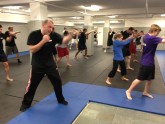The backhand is among one of my favorite light striking techniques. It’s speed is similar to that of a jab, but it’s novel angle of approach means it is hard to block. Even should an opponent manage to block your basic backhand, it leaves them wide open for a follow up attack. I’ll explain more as we go through the motions of this technique.

Assume the basic fighting stance once more, feet diagonally apart, weight centered, hands up and open. However, instead of having the leading hand over the leading foot, bring your open leading hand a bit further in, towards the center line of your body, while keeping it at the same distance away from you. As you move to strike the opponent with the lead hand, form a fist like you are going to punch them, but instead make a backhand slapping motion. This will extend your arm past the opponents guard, and potentially bring your hand in contact with their face. While it’s not a very damaging strike, the surprise of being hit by a leading hand on the opposite side of where it normally strikes is enough to throw off most opponents.
Click Here To Learn More About Kickboxing Training in Portland!
Should the opponent manage to move away from the strike, resume the guard position and try another attack. However, the instinct for many fighters when confronted with a back hand is to raise their own lead arm in defense, blocking the attack. This positioning can then be used to your advantage, as they leave their ribs, kidneys, solar plexus, and leading leg wide open to strikes and sweeps. The best follow up would be a cross punch, straight to one of their ribs. We’ll cover the cross punch in the next section of our blog.
Portland Kickboxing Technique: Muay Thai Combo #5
An advanced variant on the back hand that is more powerful would be the spinning back fist. As the name implies, this move requires you to spin during the attack, which in essence allows you to “wind up” your attack. This adds momentum to your strike, and also places you in a different position relative to your opponent, meaning their guard is suddenly ineffective unless they move with you to counter. To perform this move, you’ll want to start with a lunge towards the side you wish to attack. As you lunge, begin spinning your body, making sure to keep your weight centered and your feet flat. Spin the direction of the lunge, and strike with the fist that is in the direction of the spin. In simple terms, if you go to your left on the lunge, your spin should be left as well (counter clockwise), and your attacking fist should be the left hand. The spin will often take you past an opponent’s guard, and if they haven’t moved with you, it means that their guard is still up, so your striking fist can hit their solar plexus or ribs with a good deal of force. If their guard has adjusted to your spin, either because they anticipated the attack or reacted quicker than expected, you can usually strike at their face. This is because many opponents have a tendency to lower their guard hands when they re-adjust, leaving their face open.



